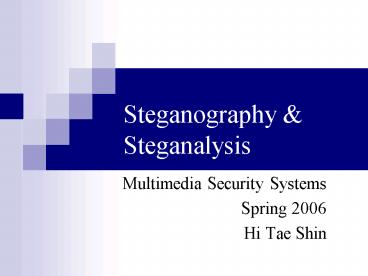Steganography PowerPoint PPT Presentation
1 / 16
Title: Steganography
1
Steganography Steganalysis
- Multimedia Security Systems
- Spring 2006
- Hi Tae Shin
2
Overview
- Introduction
- Steganography Background
- Information Hiding in JPEG files
- Steganalysis
- Statistical Analysis
- Advanced Steganography
3
Steganography Background
- Classical Steganography
- Security relies on secrecy of encoding system
- Tattoo on a shaved head (440 B.C),
- Last word in every sentence
- Least-significant bits in an image
- Modern Steganography
- Detectable only if secret information is known
- Invasive nature leaves detectable traces in
mediums characteristic
4
Steganography Background
- Information Hiding Process
- Identify redundant bits in cover medium
- Select a subset of bits to be replaced with data
from hidden message - Insert into cover medium to create stego medium
- Modifying redundant bits changes statistical
properties of cover medium
5
Information Hiding in JPEG files
- JPEG image format uses a discrete cosine
transform (DCT). - Transforms 8x8-pixel block into 64 DCT
coefficients - Modifying one coefficient affects all 64 image
pixels - Least-significant bits of quantized DCT
coefficients are used as redundant data - No known visual attacks against JPEG
steganography
6
Information Hiding in JPEG files
7
Steganalysis
- The goal of steganalysis is to identify suspected
information streams, determine whether or not
they have hidden messages encoded into them, and,
if possible, recover the hidden information. - Visual Attack
- Enhancement of intensity of LSB image
- Statistical Attack
- Chi-square test
8
Statistic Analysis
- Statistical tests can reveal that an image has
been modified by steganography by determining
that an images statistical properties deviate
from a norm. - Westfeld and Pfitzman observe that embedding of
encrypted data changes the histogram of color
frequencies. - In encrypted data, 0 and 1 bit are equally likely
- If color 2 is more frequent than color 3,
inserting encrypted data will change 2 more often
to 3, than vice versa. - Same is true for JPEG. Take frequency of the DCT
coefficients instead.
9
Statistical Analysis
- Given uniformly distributed message bits, if n2i
n2i1, then pixels with color (DCT coefficient)
with 2i are changed more frequently to color 2i1
than pixels with color 2i1 are changed to color
2i. - Thus, n2i n2i1 n2i - n2i1
10
Statistical Analysis
- Least Significant Bit
- PoV (pairs of value)
- , (-4,-3), (-2,-1), (0,1) (2,3),
- number of a particular PoV remain constant even
after embedding
JPEG DCT Coefficient Cover Image
-3
-2
-1
-4
2
0
1
3
4
0
0
0
1
1
0
1
1
1
1
1
0
0
0
0
1
2 7
0
2 7
1
-3
-2
-1
-4
2
0
1
3
4
JPEG DCT Coefficient Stego Image
11
Statistical Analysis
- ?2 test determine whether an image shows
distortion from embedding hidden data. - The probability p that the two distributions are
equal. - When two distributions are equal (p 1), the
entropy in the LSBs is maximal, indicating with
certainty that a message has been hidden
12
Statistical Analysis
- The probability of embedding calculated for
different areas of an image.
13
Statistical Analysis
- Limitation
- Targeted Analysis Jsteg
- Inability to detect steganographic images created
by other tools - Simple chi-square test does not detect advanced
steganography - Slight modification to the original method
- Advanced Steganography
- Redundant Bit Selection
- keyed PRNG to select the redundant bits
- Error Correcting Codes
- use the unmarked redundant bits and embed error
correcting codes - flipp neighboring PoV that does not fall into
selected redundant bit set
14
Advanced Steganography
- Extended chi-square test
- Simple chi-square test
15
References
- Niels Provos and Peter Honeyman. "Hide and Seek
An introduction to Steganography."
http//niels.xtdnet.nl/papers/practical.pdf
(MAY/JUNE 2003). - Neil F. Johnson and Sushil Jajodia. "Steganalysis
of Images Created Using Current Steganography
Software." http//www.jjtc.com/ihws98/jjgmu.html
(1995-2003). - Ross J. Anderson, Fabien A.P. Petitcolas. "On The
Limits of Steganography." http//www.petitcolas.ne
t/fabien/publications/jsac98-limsteg.pdf (May
1998). - Hany Farid. "Detecting Steganographic Messages in
Digital Images." http//www.cs.dartmouth.edu/fari
d/publications/tr01.pdf - Saraju P. Mohanty. "Digital Watermarking A
Tutorial Review." http//www.cs.unt.edu/smohanty/
research/Reports/MohantyWatermarkingSurvey1999.pdf
(1999)
16
- Thank You !

